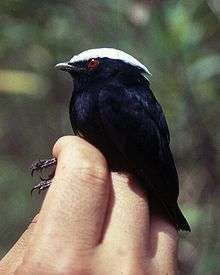White-crowned manakin
| White-crowned manakin | |
|---|---|
 | |
| Male | |
| Scientific classification | |
| Kingdom: | Animalia |
| Phylum: | Chordata |
| Class: | Aves |
| Order: | Passeriformes |
| Family: | Pipridae |
| Genus: | Dixiphia Reichenbach, 1850 |
| Species: | D. pipra |
| Binomial name | |
| Dixiphia pipra (Linnaeus, 1758) | |
| Synonyms | |
|
Pipra pipra | |
The white-crowned manakin (Dixiphia pipra) is a tiny passerine bird in the manakin family. It is a resident breeder in the tropical New World from Costa Rica to northeastern Peru and eastern Brazil. It is normally placed in the genus Pipra, but its syringeal anatomy now favours its separation as a separate genus Dixiphia. It is a small, compact bird about 10 centimetres (4 in) long. Males have black plumage with a white crown which can be erected as a creat. Females and juveniles are olive-green, with a grey head and throat, and greyish-green or olive underparts. At breeding time, males are involved in a lekking behaviour. This is a fairly common species with a wide range, and the International Union for Conservation of Nature has rated its conservation status as being of "least concern".
Distribution and habitat
It is common in mountain foothills, breeding mainly between 800–1600 m, although in northeastern Venezuela it apparently occurs down to sea level.
This is a species of the understory of wet forest and adjacent tall second growth. The nesting behaviour is undescribed, but presumably resembles that of other manakin species in which the female lays two brown-speckled white or grey eggs in a cup nest. In all manakin species, nest-building, incubation for 18–21 days, and care of the young are undertaken by the female alone, since members of this family do not form stable pairs.
Description

The white-crowned manakin is, like its relatives, a compact short-tailed bird with a stout hooked bill, dark legs and striking male plumage. It is typically 9.7–10 cm long, weighs 12 g, and has red eyes.
The adult male is mostly black with a white crown which can be erected as a low crest. His call is a buzzy jeeeeeee, louder and preceded by a popping p-p-p chee when displaying.
The female and young males are olive-green with a grey head and throat, and grey-green or olive underparts. The female of the eastern Andean race coracina is brighter and greener above and below than nominate pipra, but the combination of a grey head and red eyes makes specific identification relatively easy for a female white-crowned manakin of any race.
Ecology
Like other manakins, this species has a fascinating breeding display at a communal lek, but the leks of this species are much more dispersed than the small cleared areas favoured by most manakins, with 3-4 males just within earshot of each other, and up to 100 m apart. Males fly between horizontal perches 3–12 m high and up to 50 m apart with a swooping flight, or, when a female is present, a slow butterfly-like flutter.
The white-collared manakin feeds low in the trees on fruit and some insects, both plucked from the foliage in flight.
Status
This bird has a very wide range, is fairly common and is presumed to have a large total population. The population trend is thought to be downwards but nevertheless, the International Union for Conservation of Nature has rated the bird's conservation status as being of "least concern".[1]
References
- 1 2 BirdLife International (2012). "Pipra pipra". IUCN Red List of Threatened Species. Version 2013.2. International Union for Conservation of Nature. Retrieved 24 January 2016.
| Wikimedia Commons has media related to Dixiphia pipra. |
- Hilty, Birds of Venezuela, ISBN 0-7136-6418-5
- Stiles and Skutch, A guide to the birds of Costa Rica ISBN 0-8014-9600-4
Further reading
- Snow, D.W. (1961). "The displays of the manakins Pipra pipra and Tyranneutes virescens." Ibis 103A(1):110-113
